A Novel Method of Fabricating Al-V Intermetallic Alloy through Electrode Heating
Abstract
:1. Introduction
2. Experimental Details
2.1. Materials
2.2. Experimental Procedures
2.3. Characterization
3. Results and Discussion
3.1. Theoretical Analysis
3.2. Effect of the Materials Composition
3.3. Effect of Electrical Heating
4. Conclusions
Author Contributions
Funding
Acknowledgments
Conflicts of Interest
References
- Shi, W.J.; Wang, S.H.; Li, W.L.; Hon, M.H.; Wang, M.C. The phase transition of calcium phosphate coatings deposited on a Ti–6Al–4V substrate by an electrolytic method. J. Alloys Compd. 2007, 6, 434–435. [Google Scholar] [CrossRef]
- Li, Y.F.; Chen, C.; Han, T.F.; Ranabhat, J.; Feng, X.M.; Shen, Y.F. Microstructures and oxidation behavior of NiCrAlCoY-Al composite coatings on Ti-6Al-4V alloy substrate via high-energy mechanical alloying method. J. Alloys Compd. 2016, 697, 268. [Google Scholar] [CrossRef]
- Muroga, T.; Chen, J.M.; Chernov, V.M.; Fukumoto, K.; Hoelzer, D.T.; Kurtz, R.T.; Nagasaka, T.; Pint, B.A.; Satou, M.; Suzuki, A.; et al. Review of advances in development of vanadium alloys and MHD insulator coatings. J. Nucl. Mater. 2007, 367, 780–787. [Google Scholar] [CrossRef]
- Kurtz, R.J.; Abe, K.; Chernov, V.M.; Hoelzer, D.T.; Matsui, H.; Muroga, T.; Odette, J.R. Recent progress on development of vanadium alloys for fusion. J. Nucl. Mater. 2004, 47, 329–333. [Google Scholar] [CrossRef]
- Rahmati, B.; Sarhan, A.A.D.; Basirun, W.J.; Abas, W.A.B.W. Ceramic tantalum oxide thin film coating to enhance the corrosion and wear characteristics of Ti-6Al-4V alloy. J. Alloys Compd. 2016, 676, 369–376. [Google Scholar] [CrossRef]
- Liu, Y.; Wang, D.P.; Deng, C.Y.; Huo, L.X.; Wang, L.J.; Fang, R. Novel method to fabricate Ti–Al intermetallic compound coatings on Ti–6Al–4V alloy by combined ultrasonic impact treatment and electrospark deposition. J. Alloys Compd. 2015, 628, 208–212. [Google Scholar] [CrossRef]
- Cheng, Y. ICP-AES Determination of 15 kind of impurity elements in the vanadium-aluminum alloy. Procedia Eng. 2011, 24, 447–453. [Google Scholar]
- Chen, J.; Yan, F.Y.; Chen, B.B.; Wang, J.Z. Assessing the tribocorrosion performance of Ti–6Al–4V, 316 stainless steel and Monel K500 alloys in artificial seawater. Mater. Corros. 2014, 64, 394–401. [Google Scholar] [CrossRef]
- Cheng, C.; Dou, Z.H.; Zhang, T.A.; Zhang, H.J. Synthesis of as-cast Ti-Al-V alloy from titanium-rich material by thermite reduction. JOM 2017, 69, 1813–1823. [Google Scholar] [CrossRef]
- Li, M.; Ming, X.Q. Probe into measures to increase recovery in vanadium aluminium alloy smelting. Ferro-alloys 2000, 4, 11. [Google Scholar]
- Keller, J.G.; Douglass, D.L. The high-temperature oxidation behavior of vanadium-aluminum alloys. Oxid. Met. 1991, 36, 439–464. [Google Scholar] [CrossRef]
- Haehn, R.H.; Andorfer, H.J. Production of master alloys for the titanium industry by the GfE-two-step-process. Metall 1985, 39, 126–127. [Google Scholar]
- Yang, S.L. Vanadium Titanium Material; Metallurgical Industry Press: Beijing, China, 2007. [Google Scholar]
- Liu, S.P.; Li, J.; Lv, X.W. Temperature rising behavior of oxide materials synthesized V-Al alloy and slag after reaction in microwave field. Adv. Mater. Res. 2012, 393, 401–406. [Google Scholar] [CrossRef]
- Yang, J.; Okumura, K.; Kuwabara, M.; Sano, M. Improvement of desulfurization efficiency of molten iron with magnesium vapor produced in situ by aluminothermic reduction of magnesium oxide. Metall. Mater. Trans. B 2003, 34, 619–629. [Google Scholar] [CrossRef]
- Gao, J. Study on the production of Al-V intermediate alloy for titanium alloy. Iron Van. Titan 2001, 22, 69. [Google Scholar]
- Carlson, O.N.; Ghaneya, A.H.; Smith, J.F. The C−V (Carbon-Vanadium) system. Bull. Alloy Phase Diag. 1985, 6, 115–124. [Google Scholar] [CrossRef]
- Maglia, F.; Anselm, U.; Tamburini, C.; Milanese, N.; Bertolino, Z.A. Field activated combustion synthesis of the silicides of vanadium. J. Alloys Compd. 2001, 319, 108–118. [Google Scholar] [CrossRef]
- Falk, G.; Frank, K.D. Ferroalloy Metallurgy; Shanghai Science and Technology Press: Shanghai, China, 1978. [Google Scholar]
- Zhang, F.; Ding, E.H. The Theory and Technology of Ferroalloy Production; Metallurgical Industry Press: Beijing, China, 1994. (In Chinese) [Google Scholar]
- Guo, Q.W.; Wang, G.S.; Guo, G.C. The Nonferrous Metal Binary Alloy Phase Atlas in Commonly Used; Chemical Industry Press: Beijing, China, 2005; p. 125. [Google Scholar]
- American Society for Metals. Metallography, structures and phase diagrams. In Metal Handbook, 8th ed.; American Society for Metals: Materials Park, OH, USA, 1973. [Google Scholar]
- Ye, D.L.; Hu, J.H. Inorganic Thermodynamics Data Sheet; Beijing Metallurgical Industry Press: Beijing, China, 2002. [Google Scholar]
- La, P.Q.; Lu, X.F.; Shen, D.; Wei, Y.P.; Wang, H.D.; Guo, X. Study on high grade vanadium-aluminiumalloy prepared by aluminothermicreaction. Powder Metall. Technol. 2012, 30, 371–375. [Google Scholar]
- Bilbao, E.D.; Poirier, J.; Dombrowski, M. Corrosion of high alumina refractories by Al2O3-CaO slag: Thermodynamic and kinetic approaches. Met. Res. Technol. 2015, 112, 607. [Google Scholar] [CrossRef]
- Zhang, T.A.; Dou, Z.H.; Xu, S.W.; Yang, H. Viscosity measurement and modeling for slag systems CuCr alloys prepared via Al thermit-SHS. J. Northeastern Univ. 2004, 25, 58–61. [Google Scholar]
- Poirier, J.; Qafssaoui, F.; Ildefonse, J.P.; Bouchetou, M.L. Analysis and interpretation of refractory microstructures in studies of corrosion mechanisms by liquid oxides. J. Eur. Ceram. Soc. 2008, 28, 1557–1568. [Google Scholar] [CrossRef]
- Kurishita, H.; Kuwabara, T.; Hasegawa, M.; Kobayashi, S.; Nakai, K. Microstructural control to improve the resistance to radiation embrittlement in vanadium. J. Nucl. Mater. 2005, 343, 318–324. [Google Scholar] [CrossRef]
- Satou, M.; Nagasaka, T.; Hino, T.; Fujiwara, M.; Muroga, T.; Iikubo, T.; Abe, K. Development of V–Cr–Ti type alloys with small additives for advanced fusion applications. In Proceedings of the 21st IAEA Fusion Energy Conference, Chengdu, China, 16–22 October 2006. [Google Scholar]
- Chen, H.J.; Sun, Z.H.; Deng, X.B. Aerospace Grade Vanadium Aluminum Alloy and its Preparation Method. China Patent No. CN105755341A, 2015. [Google Scholar]
- Wan, H.L.; Xu, B.Q.; Wang, L.; Li, L.; Yang, B.; Li, L.L.; Ding, Z.; Dai, Y.N.; Li, D.M. A novel method of AlV55 alloy production by utilizing AlV65 alloy scrap. Vacuum 2018, 155, 127–133. [Google Scholar] [CrossRef]
- Liu, S.P.; Li, J.; Lv, X.W. Synthesis of V-Al alloy by microwave-assisted self-propagating. Met. Int. 2011, 16, 41. [Google Scholar]
- Liu, Z.G. The master alloy of AlV65 used for aerospace. In Titanium Industry Progress; Publisher: Xi’an, China, 2014. [Google Scholar]
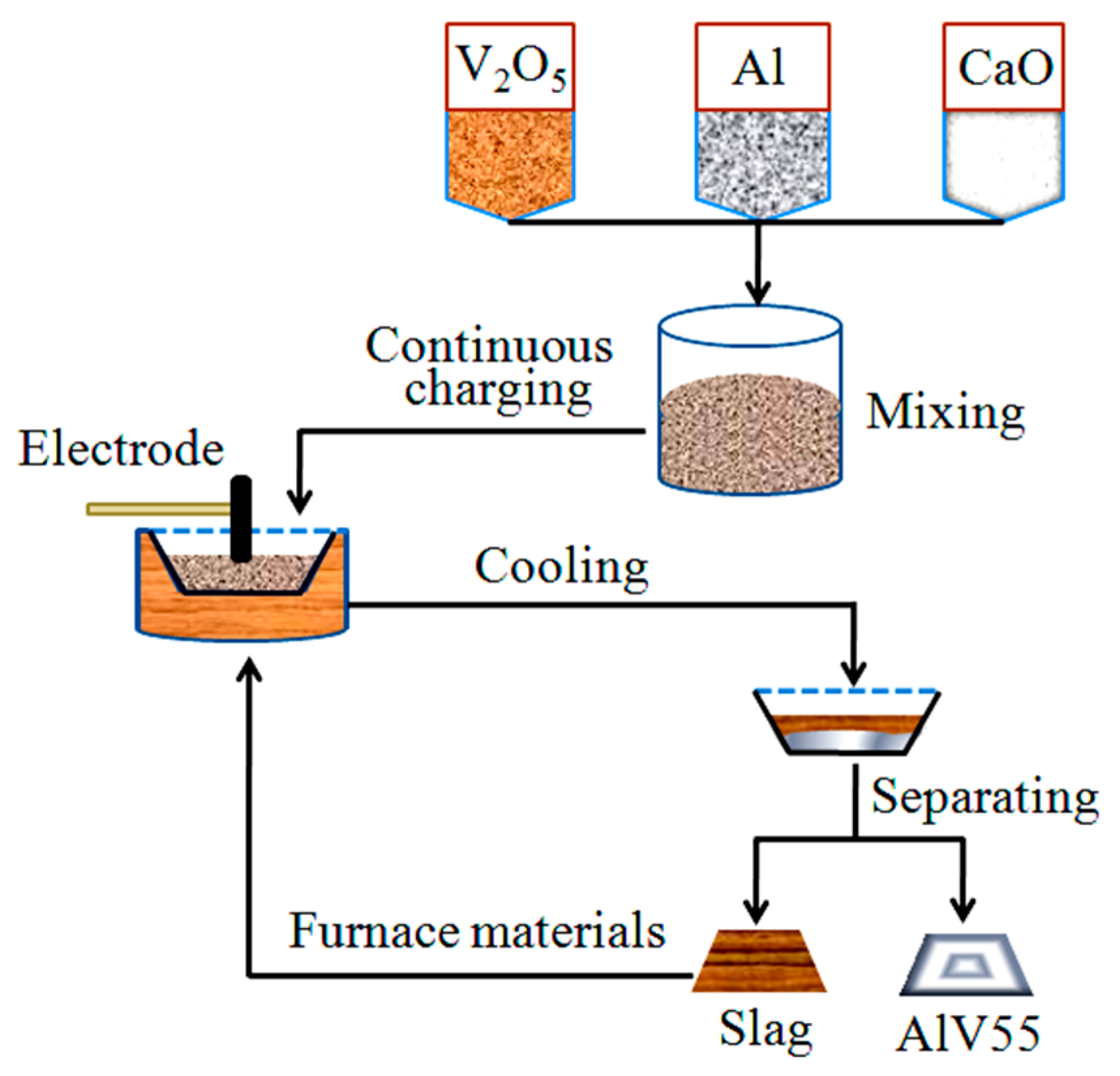
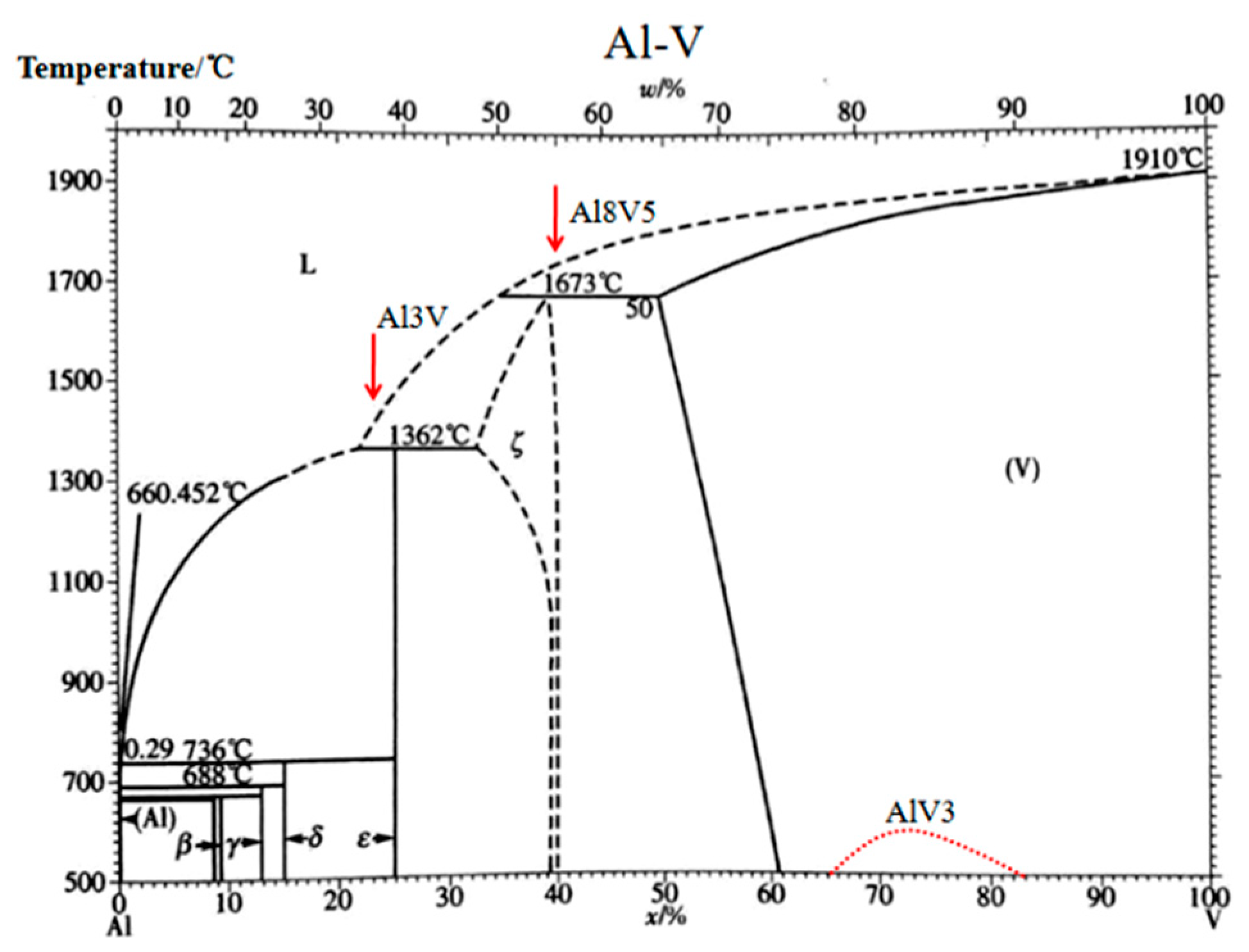
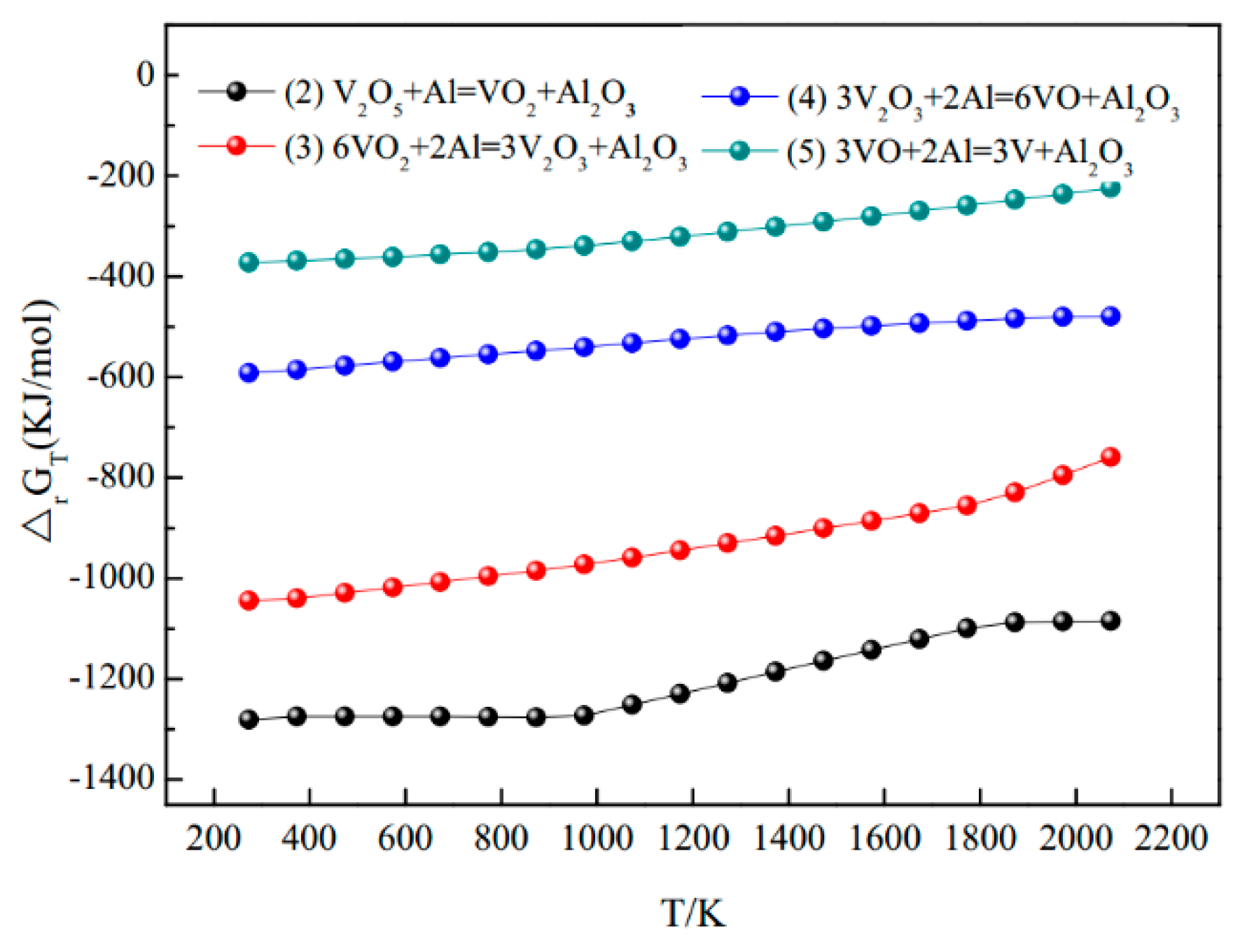
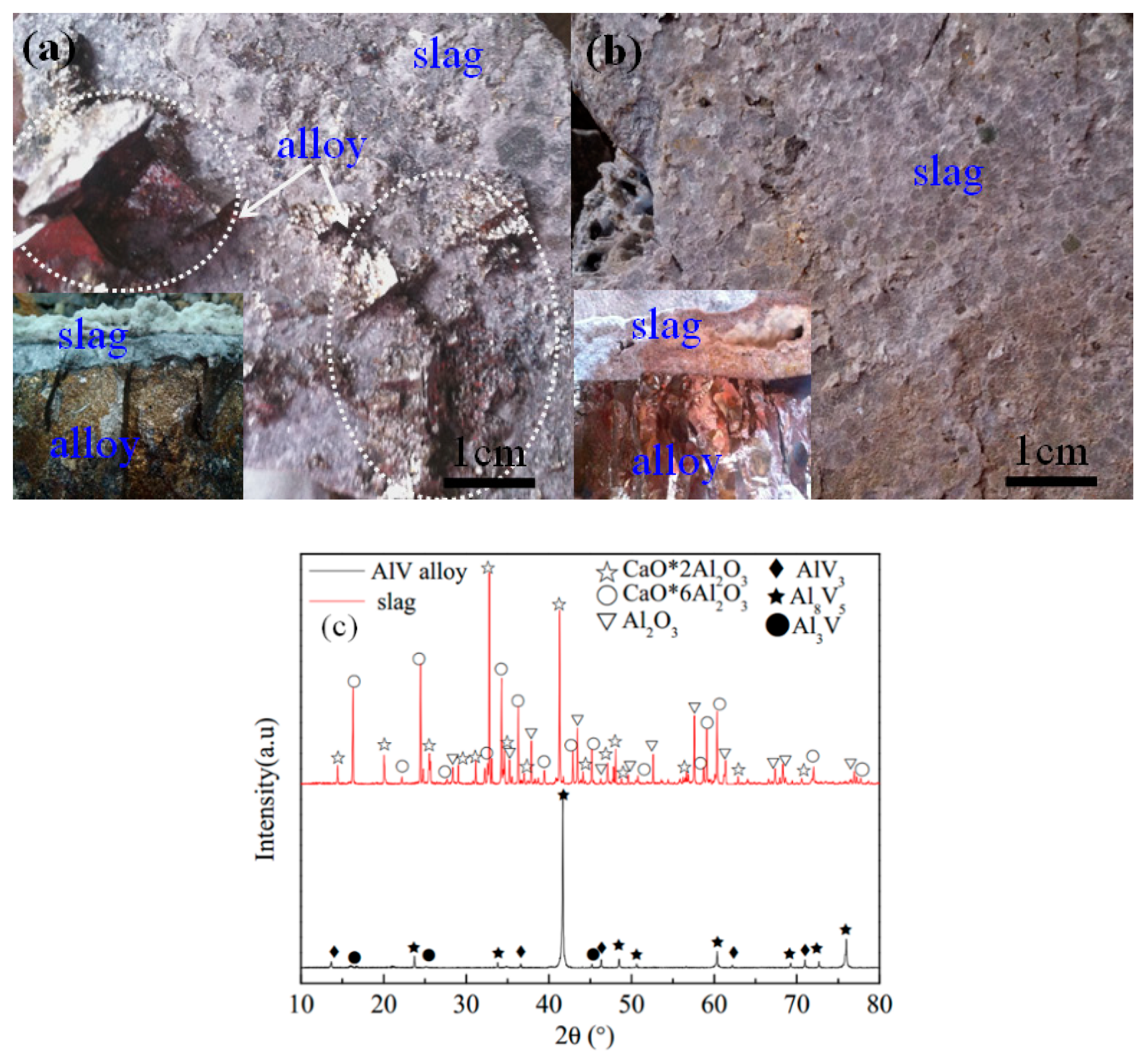
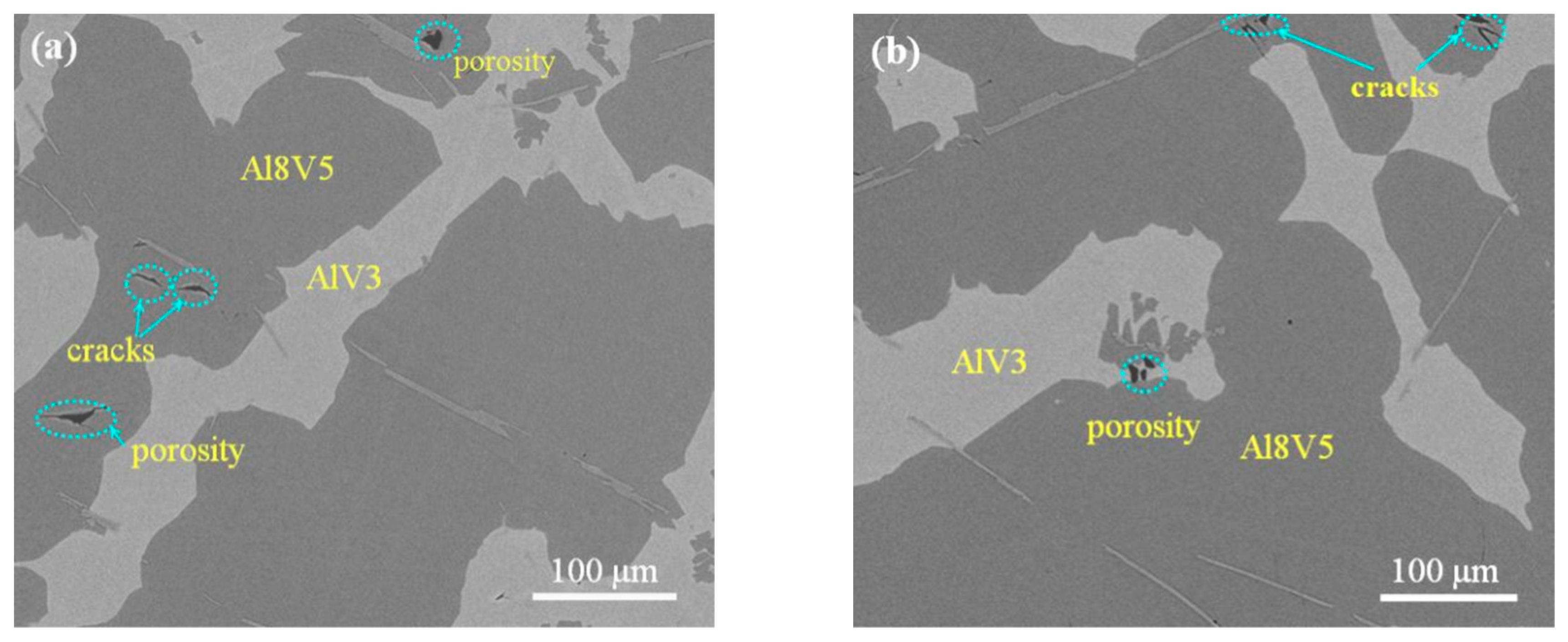
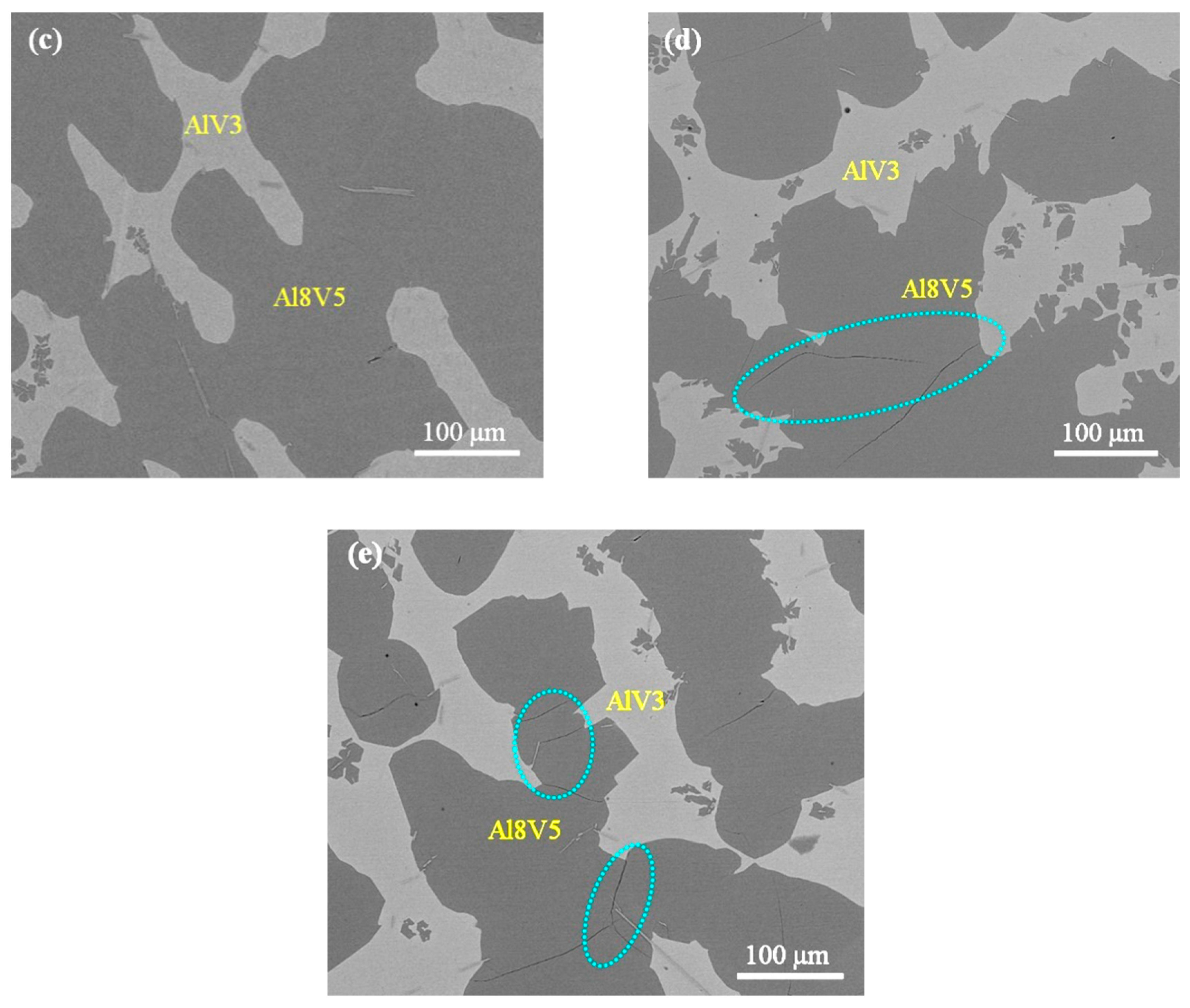
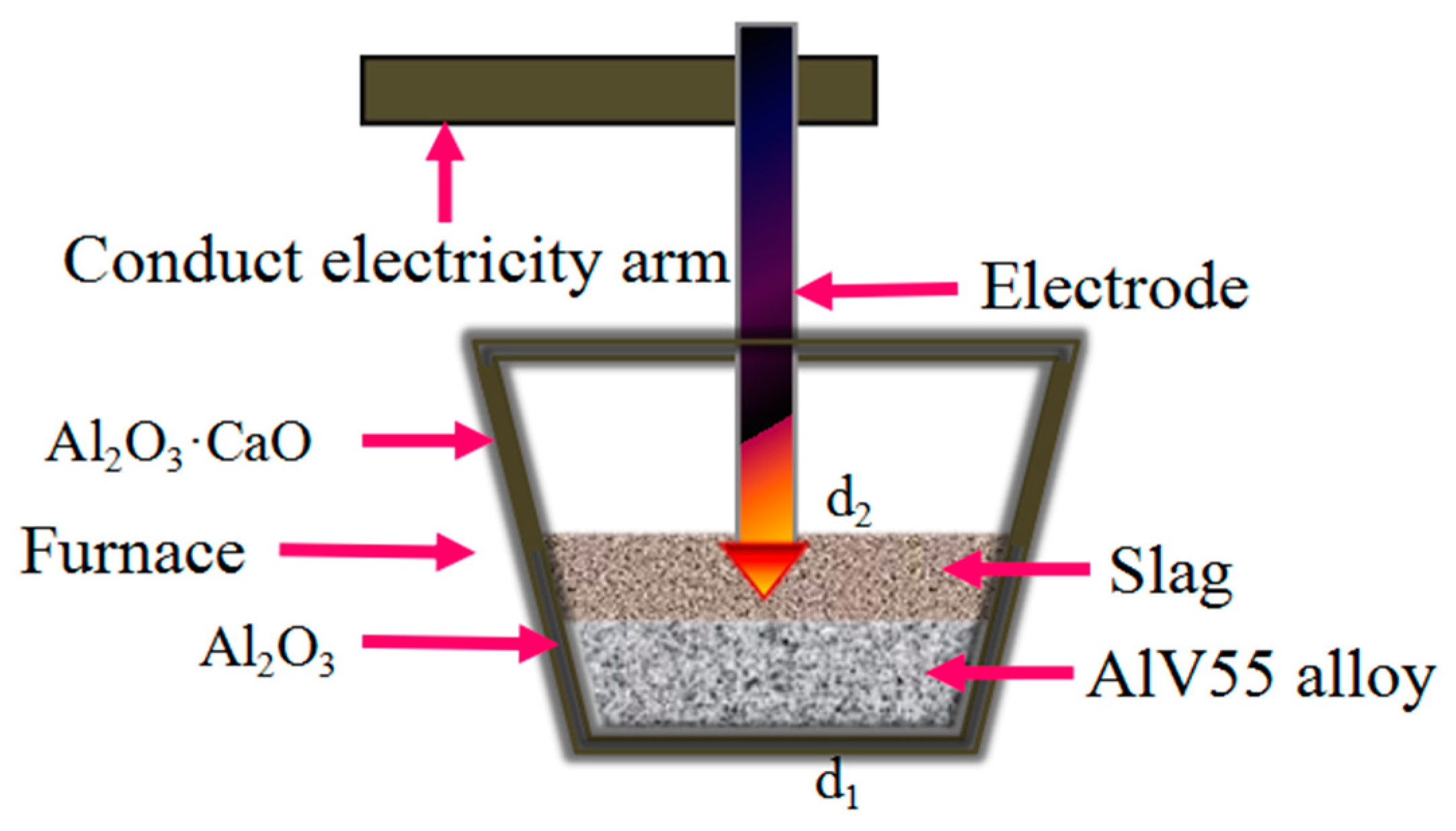
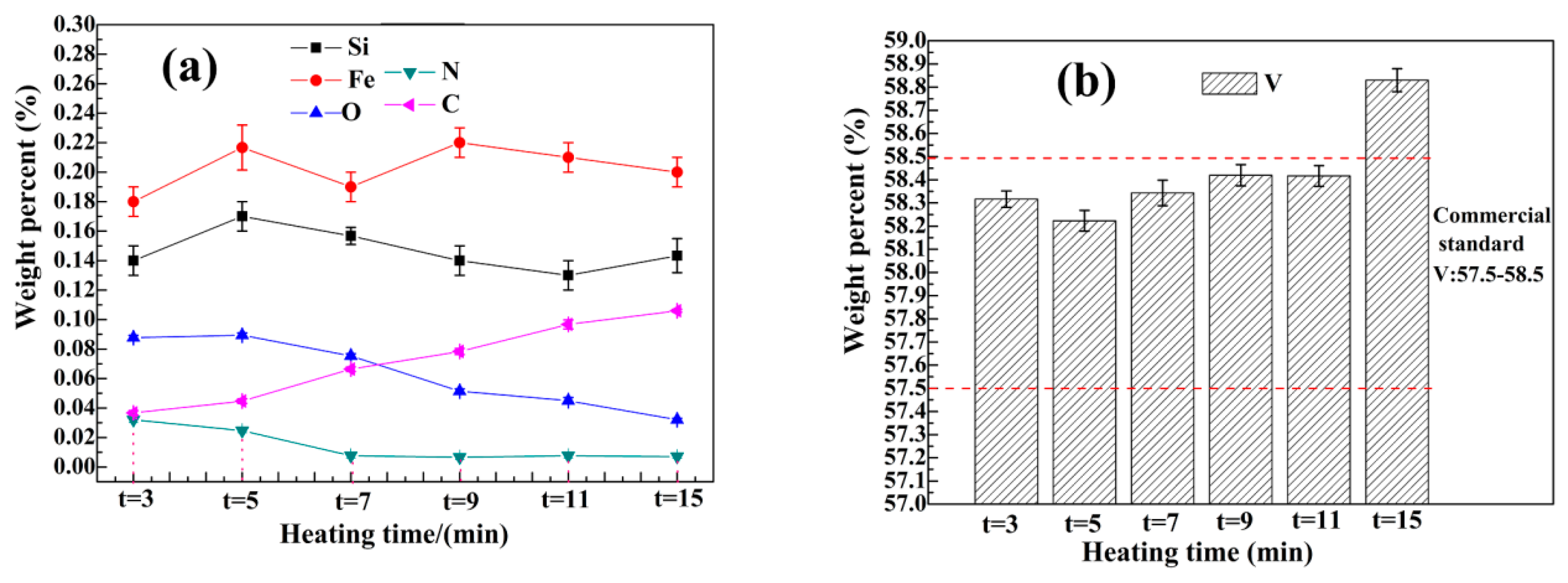
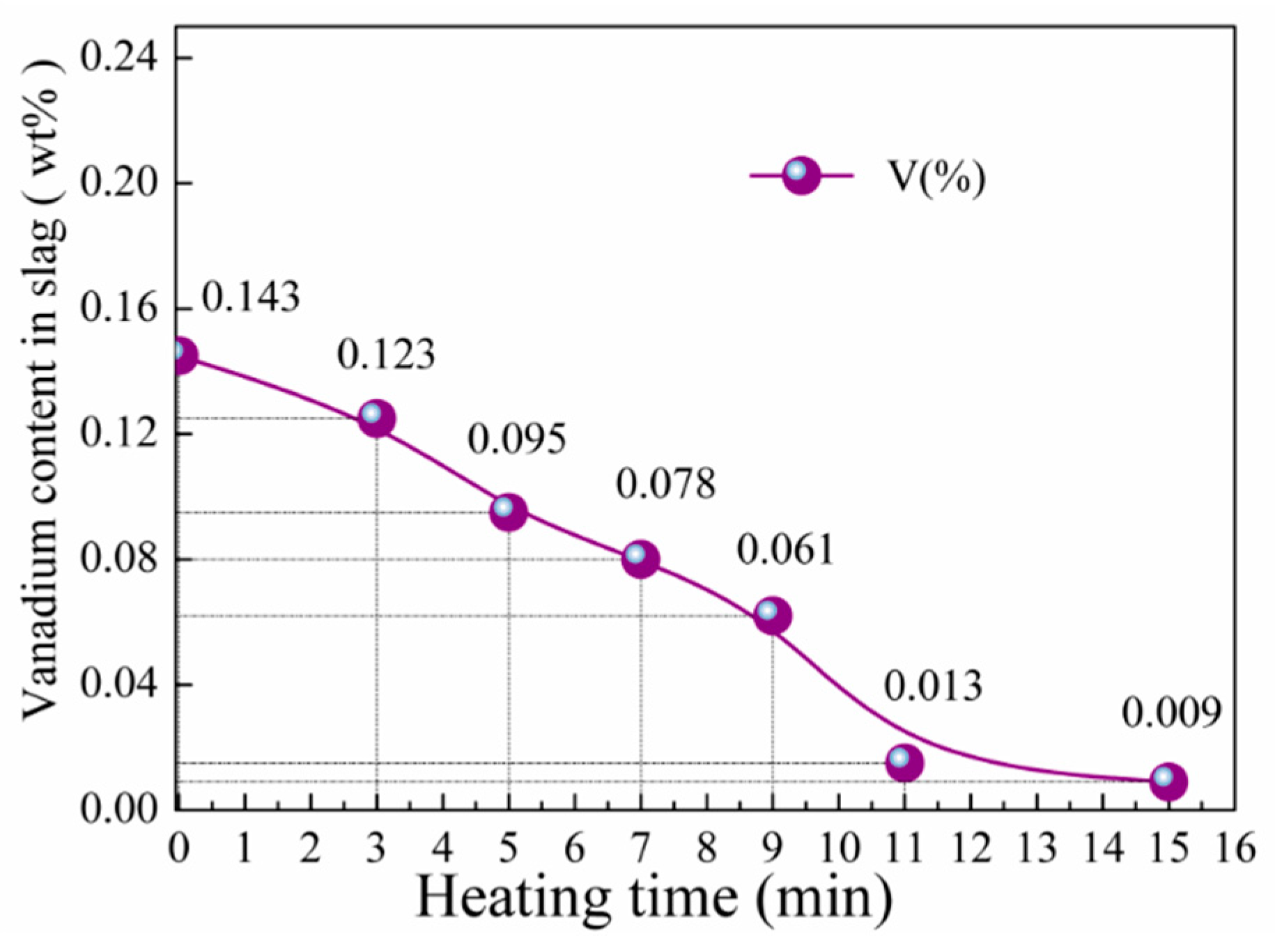
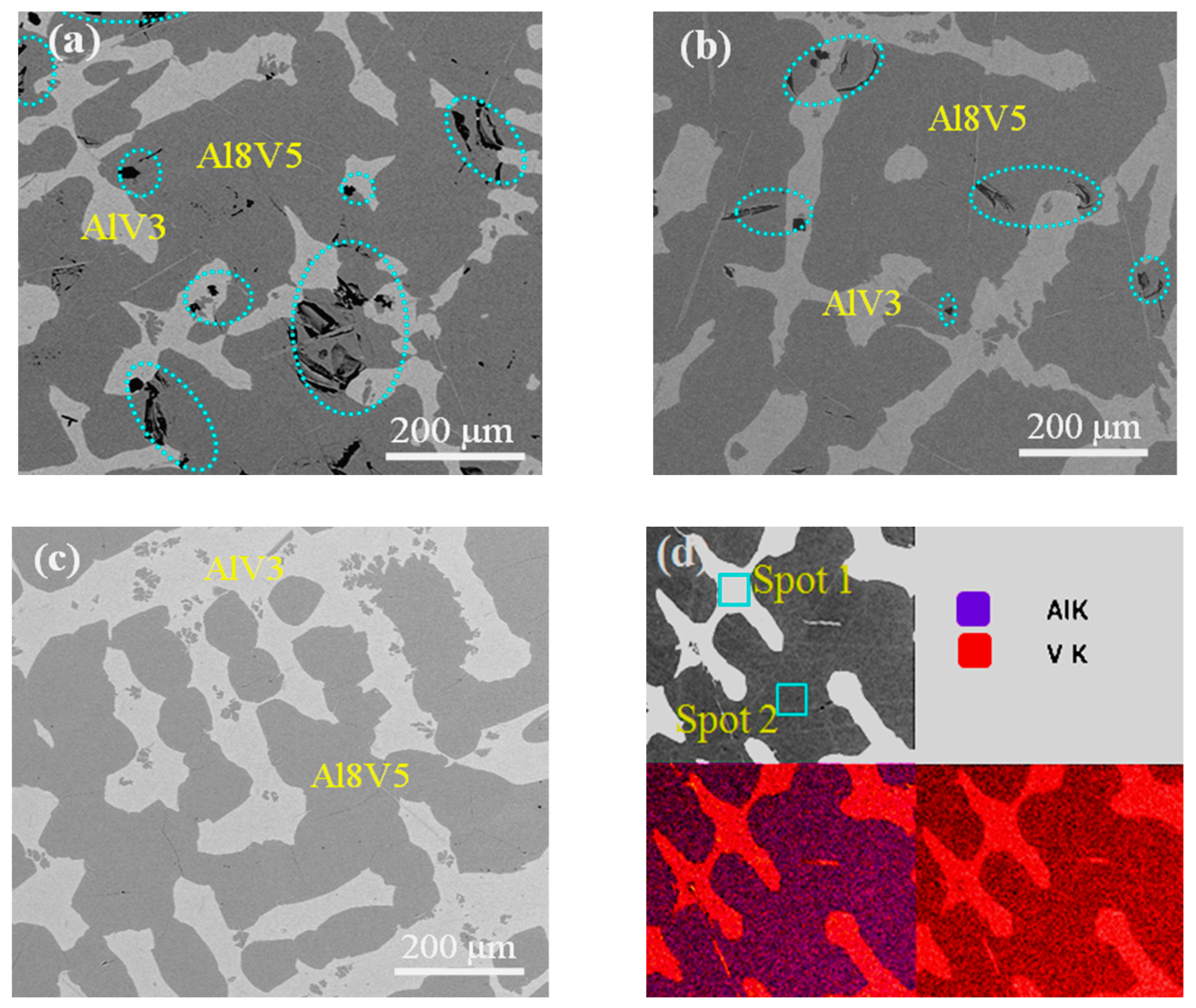
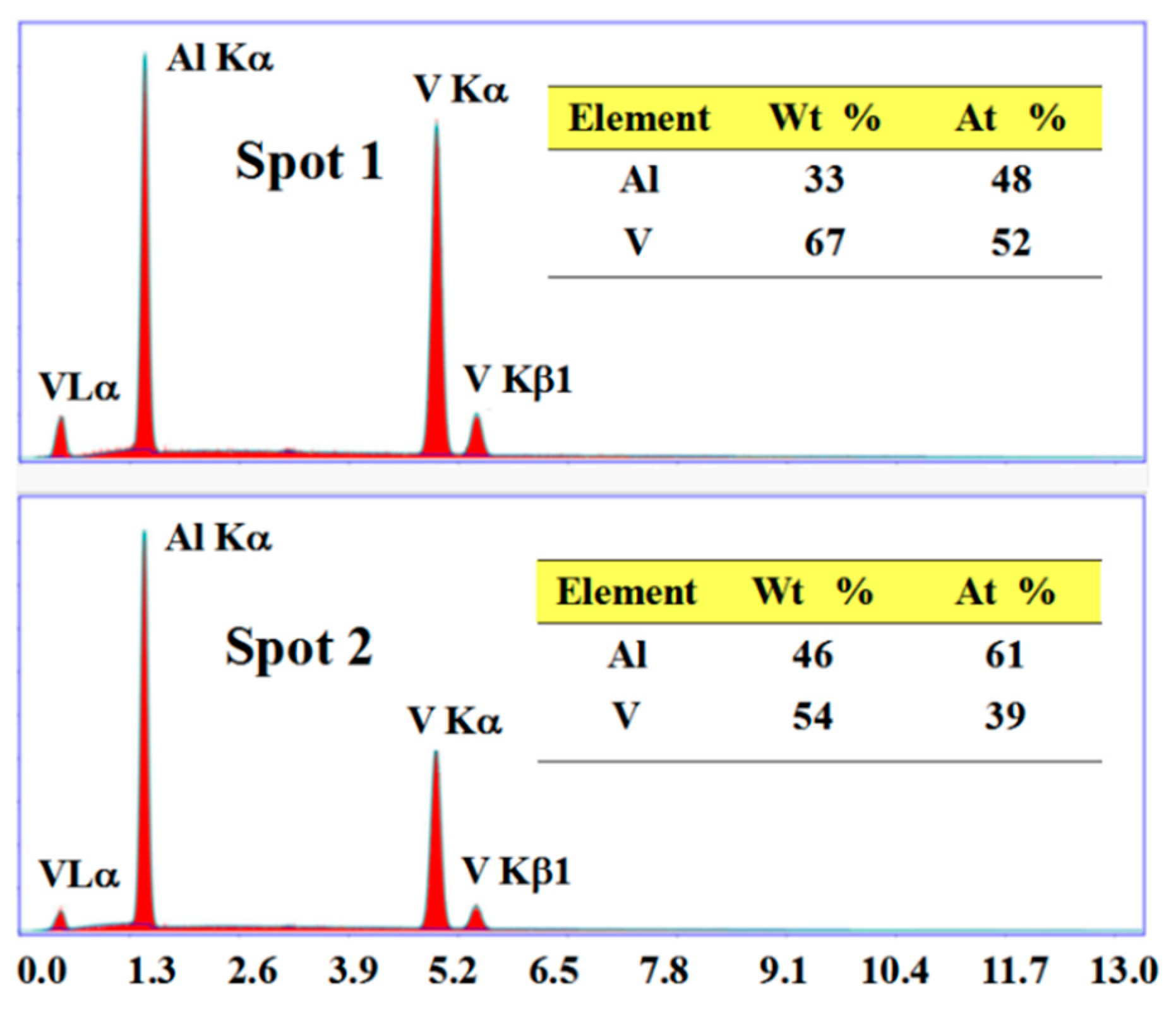
| Material | Form | Purity or Content /% a | Particle Size |
|---|---|---|---|
| V2O5 | Granules (technical grade) | V2O5 > 99%; Fe < 0.05%; Si < 0.08% | 1–3 mm |
| Al | Granules (technical grade) | Al > 99.85%; Fe < 0.1%; Si < 0.08% | 1–3 mm |
| Al2O3 | Lump (technical grade) | Al2O3 > 99%; Fe < 0.05%; Si < 0.08% | 2–5 mm |
| CaO | Powder (technical grade) | CaO > 98.5%; Fe < 0.1%; Si < 0.4% | ≤50 μm |
| AlV55 | Granules | V: 57–59%; Fe < 0.20%; Si < 0.20%; C < 0.1%; N < 0.04%; O < 0.18%; Al: remainder | ≤1 mm |
| No. | MV2O5:MCaO (kg) | MAl:MV2O5 | Heating Time (min) |
|---|---|---|---|
| 1 | 2.5:1 | 1:1 | 10 |
| 2 | 2.5:1 | 0.96:1 | 10 |
| 3 | 2.5:1 | 0.94:1 | 10 |
| 4 | 2.5:1 | 0.92:1 | 10 |
| 5 | 2.5:1 | 0.9:1 | 10 |
| Content of Element (%) | ||||||
|---|---|---|---|---|---|---|
| V | O | C | Fe | Si | N | Al |
| 57.5~58.5 | ≤0.18 | ≤0.1 | ≤0.25 | ≤0.25 | ≤0.04 | remainder |
© 2019 by the authors. Licensee MDPI, Basel, Switzerland. This article is an open access article distributed under the terms and conditions of the Creative Commons Attribution (CC BY) license (http://creativecommons.org/licenses/by/4.0/).
Share and Cite
Wan, H.; Xu, B.; Li, L.; Yang, B.; Li, D.; Dai, Y. A Novel Method of Fabricating Al-V Intermetallic Alloy through Electrode Heating. Metals 2019, 9, 558. https://doi.org/10.3390/met9050558
Wan H, Xu B, Li L, Yang B, Li D, Dai Y. A Novel Method of Fabricating Al-V Intermetallic Alloy through Electrode Heating. Metals. 2019; 9(5):558. https://doi.org/10.3390/met9050558
Chicago/Turabian StyleWan, Heli, Baoqiang Xu, Lanjie Li, Bin Yang, Dongming Li, and Yongnian Dai. 2019. "A Novel Method of Fabricating Al-V Intermetallic Alloy through Electrode Heating" Metals 9, no. 5: 558. https://doi.org/10.3390/met9050558
APA StyleWan, H., Xu, B., Li, L., Yang, B., Li, D., & Dai, Y. (2019). A Novel Method of Fabricating Al-V Intermetallic Alloy through Electrode Heating. Metals, 9(5), 558. https://doi.org/10.3390/met9050558




